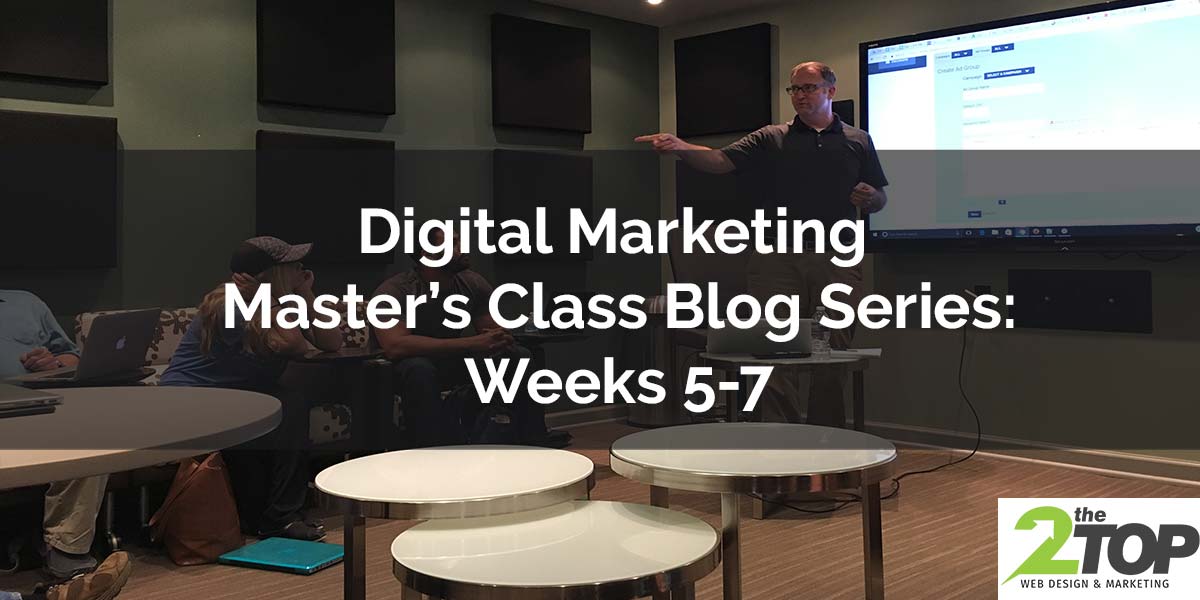Welcome to the weekly Digital Marketing Master’s Class Blog Series. My name is Riley Duncan, and I am a Digital Marketing Specialist for 2 the Top. I am very excited to be a part of the 2017 Summer Digital Marketing Master’s Class, where I will participate in all class activities as well as document the class through social media and this blog. The class runs for 14 weeks on Tuesday nights from 6 – 9 p.m. This is the third post in the series. See the first post here and the second post here.

Week 5: Paid Search Marketing
In Weeks 3 & 4, class focused on search engine optimization and ways to improve your organic search rankings. Week 5 brought us into new territory: Paid Search. Also known as PPC (Pay-Per-Click) or SEM (Search Engine Marketing), paid search is a great way to send a lot of targeted traffic to your website.
Though Google does not endorse SEO services from any agency, 2 the Top is a Google Partner for AdWords and has three AdWords certified professionals on staff. Knowing how to set up and run paid search campaigns on Google AdWords is a must for any digital marketer.
Here are just a few of the aspects of Paid Search that we covered:
- The Anatomy of a Text Ad
- Writing Effective Copy
- Keyword Research
- Keyword Match Types
- AdWords Account Structure
Since it’s difficult to get AdWords experience without spending money, we used a simulation tool called Mimic Pro that allows you to create paid search campaigns from start to finish. We ran into some problems with the software working properly, but going through the process still proved valuable.
Week 6: Online Advertising
Paid search is just one way of advertising online, so in Week 6, we learned about other ways to send paid traffic to a website. Online ads can help drive sales, especially when you put remarketing strategies into place.
We got into a discussion about ad networks and how they work, examining the perspective of both publishers and advertisers. We also discussed the different types of advertising bids, including CPC (Cost Per Click), CPM (Cost Per Mille, or Cost Per 1,000 Impressions), and CPA (Cost Per Acquisition).
In addition, Chapters 6 & 7 covered:
- Targeting the Right Audience
- Banner Ad Design
- Optimizing Banner Ads
- Consistent Messaging
- Landing Pages
- Conversion Rate Optimization
We continued our Mimic Pro simulation efforts and also wrote another Yelp review, which we compared to the one we wrote weeks ago. Yelp again filtered out some of my classmates’ reviews, so we discussed what goes into a quality review and why Yelp may be filtering some of them out.
Week 7: Analytics
After a week off for the Fourth of July, we returned in Week Seven with a lot to accomplish. We went over the next chapter, Analytics, but also took our mid-term and spent some time with Ross going over our final projects.
For final projects, students can choose from a number of different options to put what we’ve learned to use in the real world. Some students will run AdWords campaigns, others will implement SEO changes, and others will run e-mail or social media campaigns.
While students took turns meeting with Ross 1-on-1, I led the class in a discussion centered around the Analytics of one of Ross’s websites. We talked about slicing and dicing the data in different ways, and I talked about some of the features that I use most often.
As homework, we were tasked with reading and taking the quiz for Chapter 9, on Email Marketing. We also were assigned a case study to read, which centered around accurate attribution. I’m excited for the discussions we’ll have on these topics in Week 8.
Make sure to follow us on Facebook and Twitter for live updates, and I’ll post another blog in a couple weeks!
